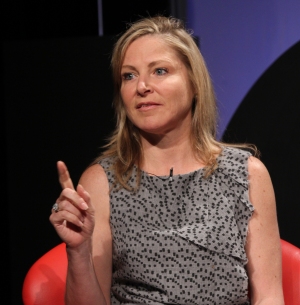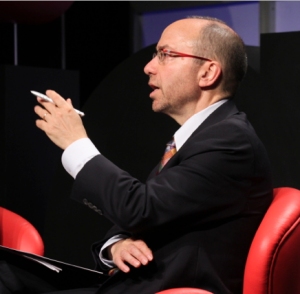One of the key themes at the Interactive Advertising Bureau’s (IAB) third annual Innovation Days conference was simply the need for the marketing industry to keep up.
Much of the pre-conference buzz was about the series of upfront programming previews – gatherings throughout the week where networks and cable-casters preview their offerings for the next television year. And, for one IAB keynoter, the old-media show-and-tells seemed anachronistic in an interactive world.
"I sat through an upfront meeting yesterday and there was a lot of great content, great information," said Kim Kadlec, Johnson & Johnson Worldwide VP Global Marketing Group. "But I still had the impression that this was an industry desperately working to preserve the past."

Photo credit: Doug Goodman
She continued: "As I sat and listened to programs for Monday, Tuesday, and Wednesday, I thought, ‘These people must not have any kids.’ My children don’t care what’s on at a particular time. They watch it when they want to watch it."
Kadlec’s challenge to broadcasters: get used to an on-demand world – "what it might look like, how it might support their model with wonderful content that comes in a way that consumers want to consume."
Randall Rothenberg, IAB President/CEO, also threw down a challenge – but this time to those working digital industry. The future, he said, is "all about screens – all kinds of screens. In fact, we live in a screen-drenched world".

Photo credit: Doug Goodman
The innovation challenge in that environment, he added, extends far beyond traditional touchpoints with consumers. "We have to figure out how all the different screens come together – how they represent new experiences and opportunities in our ecosystem."
The IAB head raised the issue of professional performance standards. In recent years, the organization has conducted research on the topic, commissioning an Interactive AD IQ Industry Survey with consultancy Ernst & Young as well as conducting a series of in-depth interviews with sales professionals.
The findings showed that many professionals on both the sell-side and buy-side are struggling to keep up with the rapid evolution of interactive advertising platforms, technologies and capabilities. Yet, they agree that a deep understanding of these areas is critical to their success and the growth of the industry.
In an effort to close that knowledge gap, Rothenberg announced the launch of the IAB Digital Media Sales Certification.
Said Michael Theodore, IAB VP/member services, who oversaw the IAB accreditation-program development, "Much like examinations in other fields, this test will give current job holders and job seekers a ‘score card’ to prove their understanding of the most important concepts, guidelines, and best practices in digital advertising. Businesses also benefit by ensuring that they have the most competent sales teams possible."
To develop the new program, Theodore worked with a committee of IAB members that included BBC, CNN Money, Condé Nast, Media Group, Disney, and Google.
The program is an English-language-based offering that, Rothenberg said, would be available to digital trade organizations globally, including groups in Shanghai and the UK.
Specific topics, according to the IAB, will include:
- Differentiating the benefits of digital versus traditional media;
- Describing digital advertising formats;
- Defining key digital advertising tools and technologies;
- Calculating media mathematics;
- Adhering to compliance standards/policies;
- Understanding differences in digital ad formats;
- Prospecting for new clients;
- Aligning digital advertising products with client objectives;
- Comprehending internal and third-party research;
- Analyzing, launching, and monitoring digital advertising campaigns and data;
- Reviewing opportunities to renew or upsell digital advertising campaigns.
Further full-length reports from Innovation Days will be available to Warc subscribers in the Conference Reports section.

